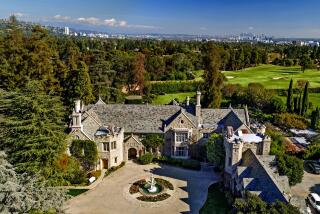For Almost a Century, Muirfield Has Held Sway : British Open Course by the Firth of Forth Has a Bleak and Forbidding Aspect
- Share via
MUIRFIELD, Scotland — Ben Crenshaw still remembers how embarrassed he felt one evening seven years ago when he and Tom Watson were chased off the hallowed grounds of the Muirfield golf course.
It was only a couple of hours after Watson had won the 1980 British Open.
Crenshaw and Watson had come into possession of some ancient clubs and even older balls, featheries. And they decided to play a couple of holes with the centuries-old equipment.
“We were just going to play two holes, out and back, and we were out on the golf course when here he came, howling and waving his arms, his dog at his heels,” Crenshaw said.
It was Paddy Hamner, Royal Navy, retired, a curmudgeon who served for so many years as Muirfield’s secretary.
“ ‘What are you doing?’ ” Crenshaw remembered him demanding. “ ‘The course is closed. You’re not allowed here. Leave immediately.’ And those were the nice things he said.
“Here’s Watson, he’s just won the British Open, and Capt. Hamner is giving us what for.
“I’m standing there on Muirfield, one of the great golf courses in the world, with a niblik in one hand and a featherie in the other and he’s making me feel like a 6-year-old boy standing in front of the principal’s desk,” Crenshaw said.
Paddy Hamner is retired now, so the participants in the 116th British Open this week will have to contend only with the course he guarded so zealously.
It is a course rich in golf history, and one which has come to be among the sport’s most revered.
Perhaps as a salve to Crenshaw’s Hamner-wounded ego, a quote by Crenshaw is displayed in the current secretary’s office: “It is the most straightforward and honest golf course in the world. There are no tricks at Muirfield.”
Elsewhere in the clubhouse are displayed the original rules of golf, drawn up in 1744 by the Company of Gentlemen Golfers, and the Bett Book.
Of the three, the course is much the youngest.
Muirfield was laid out in 1891 by Old Tom Morris for the Honourable Company of Edinburgh Golfers--lineal descendants of the Company of Gentlemen Golfers--after their previous homes in Leith and Mussleburgh had become too crowded.
Eighteenth- and 19th-Century members often would gather in the clubhouse, and, over after-dinner port, claret and sherry, arrange their games and bets for the following day. These were dutifully recorded in the Bett Book by the recorder, just as they are today.
The prime rule of these games was play or pay. This rarely happened, but it did on Feb. 9, 1809. The Bett Book records: “C vs. M not played. C funked.”
The Gentlemen Golfers had played at Leith at least since the 15th Century. They were recognized by the Edinburgh Town Council in 1744--10 years before the Royal and Ancient Golf Club of St. Andrews was founded--and the club is acknowledged as the oldest in the world.
The Gentlemen Golfers in time became the Honourable Company, which was instrumental in reviving the British Open.
In 1870, young Tom Morris, son of Old Tom, scored a third consecutive victory and retired the championship belt. The tournament was not held in 1871.
The next year, however, the Honourable Company, along with the Royal and Ancient, and Old Prestwick, founded the trophy that exists today. Those three clubs were host to the Open in rotation until 1894.
The Open first was held at Muirfield in 1892, a year after Old Tom laid it out in concentric circles on the southern lip of the Firth of Forth.
The course is famous for its bunkers, 165 of them, precisely placed to gather the errant shot. Many of them are extremely deep with very steep faces, often forcing a play away from the hole simply to get the ball back to the surface.
Only one stretch of three holes, the third, fourth and fifth, play in the same direction, forcing a player to cope with constantly changing wind directions.
There is no water and very few trees. The course is bounded on three sides by a low, gray, stone wall. On the north are the sand dunes of the firth. With the knee-deep gorse and heather moving with the winds off the North Sea and lowering gray skies above, it can be a bleak and forbidding place.
More to Read
Go beyond the scoreboard
Get the latest on L.A.'s teams in the daily Sports Report newsletter.
You may occasionally receive promotional content from the Los Angeles Times.









